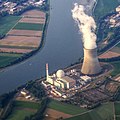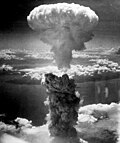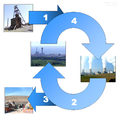Portal:Nuclear technology
The Nuclear Technology Portal
Introduction

- Nuclear technology is technology that involves the nuclear reactions of atomic nuclei. Among the notable nuclear technologies are nuclear reactors, nuclear medicine and nuclear weapons. It is also used, among other things, in smoke detectors and gun sights. (Full article...)
- Nuclear power is the use of nuclear reactions to produce electricity. Nuclear power can be obtained from nuclear fission, nuclear decay and nuclear fusion reactions. Presently, the vast majority of electricity from nuclear power is produced by nuclear fission of uranium and plutonium in nuclear power plants. Nuclear decay processes are used in niche applications such as radioisotope thermoelectric generators in some space probes such as Voyager 2. Reactors producing controlled fusion power have been operated since 1958 but have yet to generate net power and are not expected to be commercially available in the near future. (Full article...)
- A nuclear weapon is an explosive device that derives its destructive force from nuclear reactions, either fission (fission or atomic bomb) or a combination of fission and fusion reactions (thermonuclear weapon), producing a nuclear explosion. Both bomb types release large quantities of energy from relatively small amounts of matter. (Full article...)
General images -
Selected article -
The United Kingdom signed the Comprehensive Nuclear Test Ban Treaty in 1996 and ratified it in 1998, confirming the British commitment towards ending nuclear test explosions in the world. (Full article...)
Selected picture -
Did you know?
- ... that an official investigation found the Fukushima nuclear accident was foreseeable and preventable?
- ... that poet Peggy Pond Church became a strong pacifist and a member of the Society of Friends after the Manhattan Project used her home as a place to build nuclear weapons?
- ... that during World War II, pilot G. E. Clements was removed from training for secret missions associated with the Manhattan Project when senior officers realized she was a woman?
- ... that the Manhattan Project feed materials program used uranium ore from a mine in Canada near the Arctic Circle?
- ... that Fritz Strassmann, a co-discoverer of nuclear fission, concealed a Jewish woman in his home during World War II?
- ... that the British National Hospital Service Reserve trained volunteers to carry out first aid in the aftermath of a nuclear or chemical attack?
Related WikiProjects
Things you can do
| Parts of this portal (those related to section) need to be updated. Please help update this portal to reflect recent events or newly available information. Relevant discussion may be found on the talk page. (September 2021) |
|
Here are some Open Tasks :
|
Selected biography -
The son of a U.S. Army chaplain, Groves lived at various Army posts during his childhood. In 1918, he graduated fourth in his class at the United States Military Academy at West Point and was commissioned into the United States Army Corps of Engineers. In 1929, he went to Nicaragua as part of an expedition to conduct a survey for the Inter-Oceanic Nicaragua Canal. Following the 1931 Nicaraguan earthquake, Groves took over Managua's water supply system, for which he was awarded the Nicaraguan Presidential Medal of Merit. He attended the Command and General Staff School at Fort Leavenworth, Kansas, in 1935 and 1936, and the Army War College in 1938 and 1939, after which he was posted to the War Department General Staff. Groves developed "a reputation as a doer, a driver, and a stickler for duty". In 1940 he became special assistant for construction to the Quartermaster General, tasked with inspecting construction sites and checking on their progress. In August 1941, he was appointed to create the gigantic office complex for the War Department's 40,000 staff that would ultimately become the Pentagon.
In September 1942, Groves took charge of the Manhattan Project. He was involved in most aspects of the atomic bomb's development: he participated in the selection of sites for research and production at Oak Ridge, Tennessee; Los Alamos, New Mexico; and Hanford, Washington. He directed the enormous construction effort, made critical decisions on the various methods of isotope separation, acquired raw materials, directed the collection of military intelligence on the German nuclear energy project and helped select the cities in Japan that were chosen as targets. Groves wrapped the Manhattan Project in security, but spies working within the project were able to pass some of its most important secrets to the Soviet Union.
After the war, Groves remained in charge of the Manhattan Project until responsibility for nuclear weapons production was handed over to the United States Atomic Energy Commission in 1947. He then headed the Armed Forces Special Weapons Project, which had been created to control the military aspects of nuclear weapons. He was given a dressing down by the Chief of Staff of the Army, General of the Army Dwight D. Eisenhower, on the basis of various complaints, and told that he would never be appointed Chief of Engineers. Three days later, Groves announced his intention to leave the Army. He was promoted to lieutenant general just before his retirement on 29 February 1948 in recognition of his leadership of the bomb program. By a special act of Congress, his date of rank was backdated to 16 July 1945, the date of the Trinity nuclear test. He went on to become a vice president at Sperry Rand. (Full article...)
Nuclear technology news
- 13 June 2025 – Middle Eastern crisis
- The Israeli Air Force launches a bombing campaign against Iran targeting nuclear facilities with the main goal of the operation being to destroy Iran's nuclear program. A special state of emergency is declared in Israel by Defence Minister Israel Katz and Israeli airspace is closed to all flights. Iranian state television reports that 60 people were killed in the attacks, while Israel claims only three people died and dozens got injured. (BBC News)
- Israel also launches targeted assassination strikes against senior Iranian government officials, Iranian military leadership and senior nuclear scientists. (Reuters)
- The Israeli military confirms it has targeted nuclear facilities in Iran with the main goal of the operation being to destroy Iran's nuclear program. Israeli prime minister Benjamin Netanyahu confirms Israeli warplanes have targeted Iran's main Natanz Nuclear Facility. It is later confirmed that the underground nuclear reactor at Natanz has been destroyed by a bunker buster. (The Jerusalem Post) (BBC News)
- Israeli decapitation strikes kill commander-in-chief of the Islamic Revolutionary Guard Corps Hossein Salami, senior nuclear scientist and former head of the Atomic Energy Organization of Iran Fereydoon Abbasi, and chief of the General Staff of the Armed Forces of the Islamic Republic of Iran Mohammad Bagheri and Quds Force commander Esmail Qaani. (The Times of Israel) (BBC News)
Related portals
Related topics
Subcategories
Associated Wikimedia
The following Wikimedia Foundation sister projects provide more on this subject:
-
Commons
Free media repository -
Wikibooks
Free textbooks and manuals -
Wikidata
Free knowledge base -
Wikinews
Free-content news -
Wikiquote
Collection of quotations -
Wikisource
Free-content library -
Wikiversity
Free learning tools -
Wiktionary
Dictionary and thesaurus





































































































